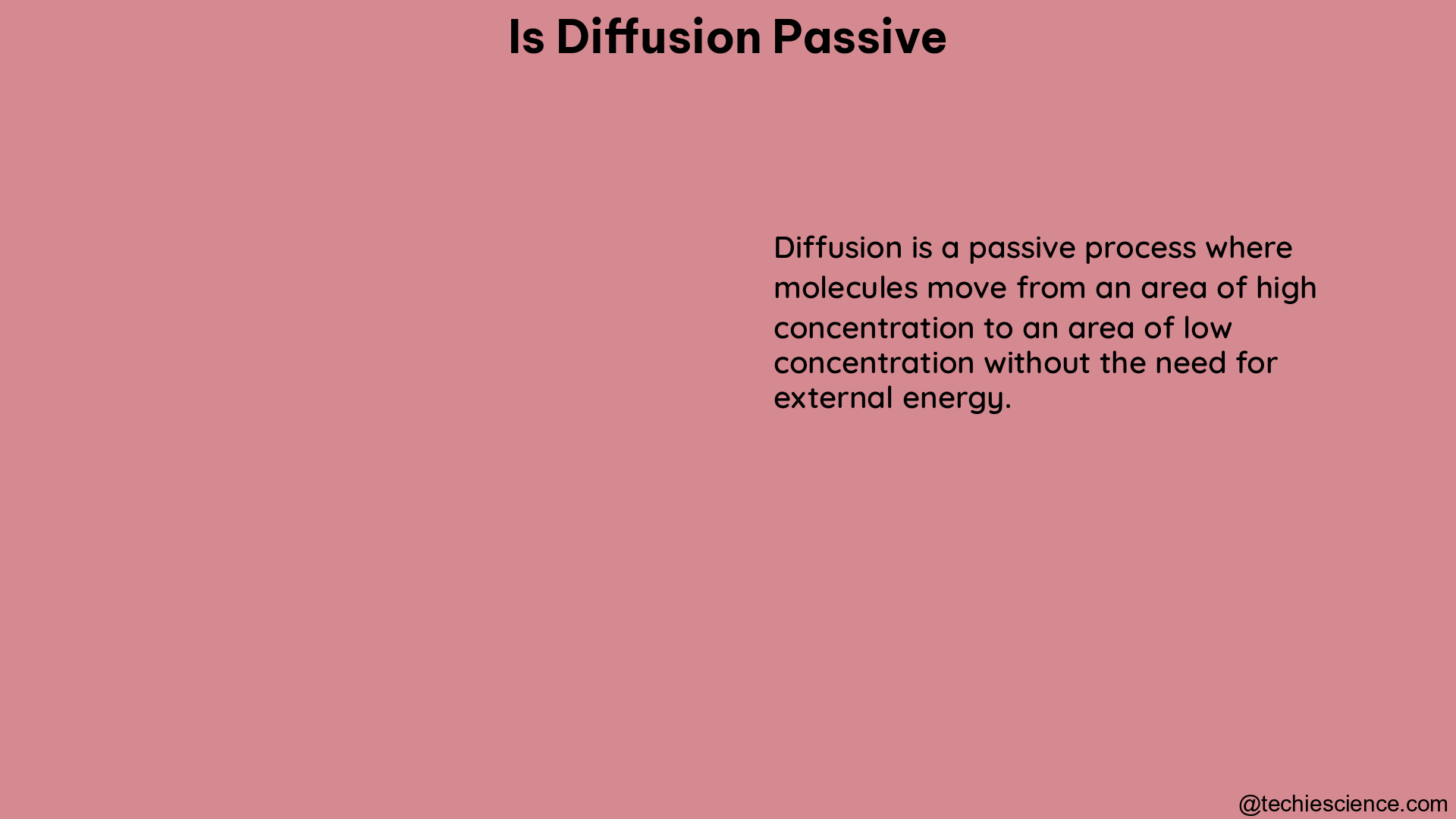Diffusion is a fundamental process in biology, allowing the movement of particles across membranes without the expenditure of energy. This passive transport mechanism is crucial for various cellular processes, from gas exchange to the regulation of cellular homeostasis. In this comprehensive guide, we will delve into the intricacies of passive diffusion, exploring its mechanisms, influencing factors, and the latest research on this topic.
Understanding Passive Diffusion
Passive diffusion is a spontaneous process driven by the random thermal motion of particles, known as Brownian motion. This motion leads to the net movement of particles from an area of high concentration to an area of low concentration, without the need for any external energy input. The rate of passive diffusion is influenced by several factors, including the size and charge of the diffusing particles, the temperature of the system, and the concentration gradient across the membrane.
Factors Affecting Passive Diffusion Rates
-
Particle Size: The size of the diffusing particles is a critical factor in determining the rate of passive diffusion. Smaller particles, such as oxygen and carbon dioxide, can easily pass through the phospholipid bilayer of the cell membrane, while larger or charged particles often require specialized protein channels to facilitate their movement.
-
Temperature: The rate of passive diffusion is directly proportional to the temperature of the system. As the temperature increases, the kinetic energy of the particles increases, leading to a higher rate of diffusion. This relationship is described by the Arrhenius equation, which relates the rate constant of a chemical reaction to the temperature.
-
Concentration Gradient: The concentration gradient, or the difference in the concentration of the diffusing particles across the membrane, is the driving force for passive diffusion. The greater the concentration gradient, the faster the rate of diffusion, as the particles will move from the area of high concentration to the area of low concentration.
-
Membrane Permeability: The permeability of the cell membrane or the biological barrier can also influence the rate of passive diffusion. Lipophilic molecules, such as oxygen and carbon dioxide, can easily diffuse through the hydrophobic core of the phospholipid bilayer, while larger or charged particles may require specialized protein channels to facilitate their movement.
Modeling Passive Diffusion
The rate of passive diffusion through protein channels can be modeled as an elementary chemical reaction with a single reaction step and a single transition state. The free energy barrier (ΔGpassive) to passive diffusion increases sublinearly with molecular mass, following the Eyring-Polanyi equation. This relationship suggests that larger particles face a higher energy barrier to diffusion, which may explain the size-selective properties of some biological channels.
Experimental measurements of passive diffusion rates can be used to calculate the permeability coefficient (p) of a single NPC (nanopore complex), which is specified in units of molecules per second per NPC per micromole, equivalent to 1.86 × 10^-6 cm/s. The permeability coefficient is a quantitative measure of the ease with which particles can diffuse through a given area.
Passive Diffusion in Biological Membranes

In the context of biological membranes, passive diffusion can occur through two main pathways: the phospholipid bilayer and protein channels.
Diffusion through the Phospholipid Bilayer
The phospholipid bilayer, which forms the core of the cell membrane, is a highly selective barrier that allows the passage of certain molecules while restricting the movement of others. Lipophilic molecules, such as oxygen, carbon dioxide, and nitrogen, can diffuse directly through the hydrophobic core of the bilayer, as they can easily dissolve in the lipid environment.
Diffusion through Protein Channels
Larger or charged particles, such as ions and larger molecules, often require specialized protein channels to facilitate their passive diffusion across the cell membrane. These protein channels, also known as pores or transporters, provide a selective and regulated pathway for the movement of specific molecules. The size, charge, and shape of the protein channels can influence the rate and selectivity of passive diffusion.
Experimental Techniques and Simulations
Researchers have developed various experimental techniques and computational simulations to study the mechanisms and dynamics of passive diffusion.
Experimental Measurements of Passive Diffusion
Experimental measurements of passive diffusion rates can be used to calculate the permeability coefficient (p) of a single NPC (nanopore complex). These measurements provide a quantitative measure of the ease with which particles can diffuse through a given area, which is essential for understanding the transport properties of biological membranes.
Brownian Dynamics Simulations
Brownian dynamics simulations can be used to test whether observations of passive diffusion can be explained by an entropy-driven model of transport. These simulations suggest that passive diffusion is indeed an entropy-driven process, in which the random motion of particles leads to a net movement from high to low concentration.
Conclusion
Passive diffusion is a fundamental and measurable process that allows particles to move across biological membranes without the expenditure of energy. The rate of diffusion is influenced by various factors, including the size and charge of the diffusing particles, the temperature, and the concentration gradient. Experimental measurements and theoretical models have provided valuable insights into the mechanisms and dynamics of passive diffusion, which are crucial for understanding cellular processes and developing targeted therapeutic strategies.
References:
- Rout, M.P., et al., Simple rules for passive diffusion through the nuclear pore complex. J Cell Biol, 2016. 215(1): p. 57-68.
- MRGScience.com, Topic 1.4 Membrane Transport. Available at: https://www.mrgscience.com/topic-14-membrane-transport.html
- ScienceDirect, Passive Diffusion – an overview. Available at: https://www.sciencedirect.com/topics/neuroscience/passive-transport
- ScienceDirect, Passive Transport – an overview. Available at: https://www.sciencedirect.com/topics/biochemistry-genetics-and-molecular-biology/passive-transport
- Biologyforlife.com, Membrane Transport. Available at: https://www.biologyforlife.com/14-membrane-transport.html

Hello, I am Piyali Das, pursuing my Post Graduation in Zoology from Calcutta University. I am very passionate on Academic Article writing. My aim is to explain complex things in simple way through my writings for the readers.